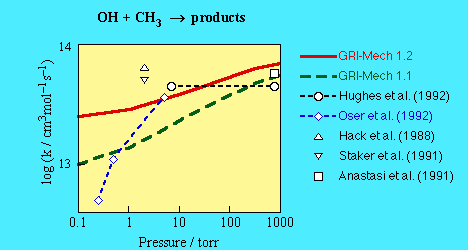The initial value is a result of a 4-channel RRKM calculation, which were fit to the decomposition data of Spindler et al. (1982), Dombrowsky et al. (1991), and Cribb et al. (1984), and the high-pressure room-temperature data of Hughes et al. (1992) and Anastasi et al. (1991).
The choice for the rate coefficient is a compromise fit to the conflicting low pressure data of Hughes et al. (1992), Hack et al. (1988), Staker et al. (1975), which favor a higher value, and of Oser et al. (1992) and Bott and Cohen (1991) (at 1200 K) which favor a lower value.
| Channel | Reaction | Reaction Number |
|---|---|---|
| 1 | CH2(S) + H2O (+M) = CH3OH (+M) | 147 |
| 2 | OH + CH3 (+M) = CH3OH (+M) | 95 |
| 3 | H + CH2OH (+M) = CH3OH (+M) | 59 |
| 4 | H + CH3O (+M) = CH3OH (+M) | 63 |
Rate coefficients computed by 4-channel RRKM calculation.
<delta-E> = 0.30 kcal/mol
The Lennard-Jones parameters: sigma(CH3OH-N2) = 3.70 A, epsilon = 270 K
Active molecular K-rotor 4.11 amu-A^2, sigma = 1
Torsion 0.705 amu-A^2, sigma = 3
Adiabatic I = 18.8 amu-A^2, sigma = 1
v = 3680, 3000, 2960, 2840, 1480, 1480, 1450, 1350, 1160, 1060, 1030 cm^(-1)
Transition state 1 CH2(S) + H2O
delta-E(0 K) = 0.0 kcal/mol;
delta-H(0 K) = -89.96 kcal/mol
Adiabatic I+ = 75.2 amu-A^2 at 1200 K (113 at 400 K), sigma = 1
(These values relative to the molecule are used for the Waage-Rabinovitch factor.)
v = 3760, 3660, 3070, 3020, 1600, 1400 cm^(-1)
Active 1-D rotors I = 2.13, 0.53 amu-A^2; sigma = 2,2
2-D hindered rotors I = 0.37, 0.28 amu-A^2 (96%) at 1200 K [0.53,
0.40 at 400 K (92%)]; sigma = 1,1
Transition state 2 OH + CH3
delta-E(0 K) = 0.0 kcal/mol;
delta-H(0 K) = -90.48 kcal/mol
Adiabatic I+ = 122 amu-A^2 at 1200 K (160 at 400 K), sigma = 1
v = 3570, 3180, 3180, 3000, 1380, 1380, 580 cm^(-1)
Active 1-D rotor I = 4.11 amu-A^2, sigma = 1
2-D hindered rotors I = 0.70, 0.30 amu-A^2 (90%) at 1200 K [0.83,
0.36 at 400 K (86%)]; sigma = 1,1
Transition state 3 H + CH2OH
delta-E(0 K) = 0.0 kcal/mol;
delta-H(0 K) = -97.3 kcal/mol
adiabatic I+ = 18.8 amu-A^2, sigma = 1
v = 3640, 3000, 3000, 1460, 1330, 1180, 1050, 950, 290 cm^(-1)
Active 1-D rotor I = 4.11 amu-A^2, sigma = 1
2-D hindered rotor I = 1.87 amu-A^2 (90%), sigma = 1
Transition state 4 H + CH3O
delta-E(0 K) = 0.0 kcal/mol;
delta-H(0 K) = -102.7 kcal/mol
Adiabatic I+ = 18.8 amu-A^2, sigma = 1
v = 3320, 3320, 3220, 1660, 1600, 1580, 1160, 1060, 720 cm^(-1)
Active 1-D rotor I = 4.11 amu-A^2, sigma = 1
2-D hindered rotor I = 0.46 amu-A^2 (90%), sigma = 1
| Reference | cm3/mol s |
|---|---|
| GRI-Mech | 8.3E8 |
| Cribb et al. (1984) | 5.4E8 |
| Spindler et al. (1982) | 1.0E9 |
| Hidaka et al. (1989) | 3.2E8 |

______________________________________________________________________
Temp delta-S delta-H kf kr Keq
(K) (cal/mol K) (kcal/mol) ----(mol,cm3,s)-----
______________________________________________________________________
300 .1 .4 2.50E+13 5.00E+13 5.00E-01
500 -.2 .3 2.50E+13 3.82E+13 6.54E-01
1000 -.8 -.1 2.50E+13 3.51E+13 7.12E-01
1500 -1.2 -.6 2.50E+13 3.71E+13 6.74E-01
2000 -1.5 -1.1 2.50E+13 3.97E+13 6.29E-01
2500 -1.6 -1.5 2.50E+13 4.23E+13 5.90E-01
3000 -1.8 -1.8 2.50E+13 4.48E+13 5.59E-01
______________________________________________________________________